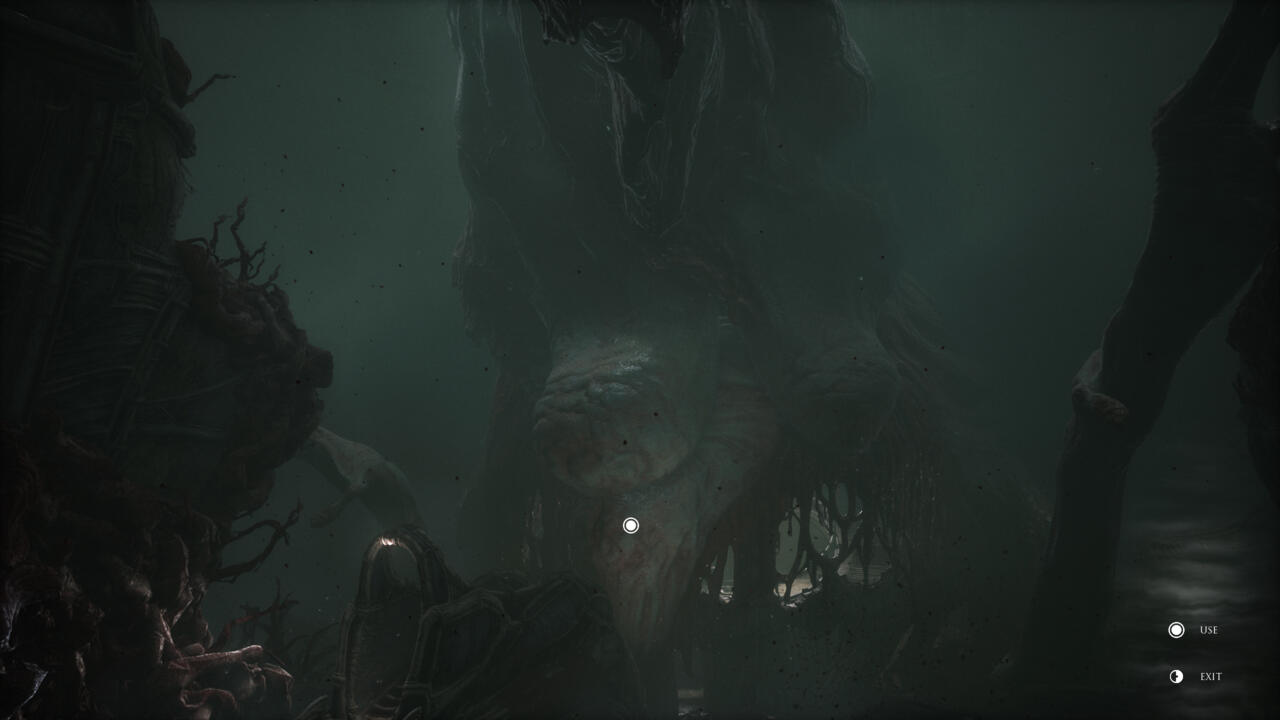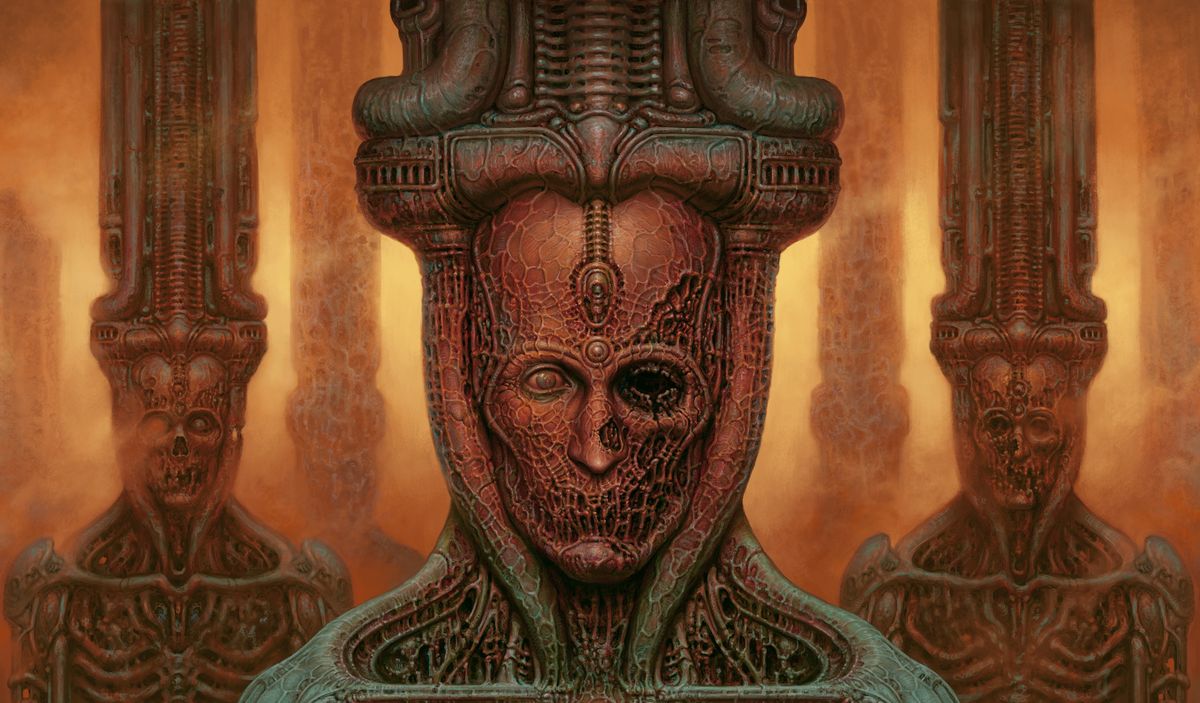Scorn is designed to be disgusting. The partitions of its labyrinthine halls are constructed with twisting contortions of flesh, and its mechanically advanced contraptions are drenched within the blood of discarded carcasses that lay decaying with out care. The inspirations of Scorn’s aesthetic are acquainted however well-implemented, creating an environment of languish and disgust that’s maintained all through. Nonetheless, disappointingly, Scorn’s infuriatingly unbalanced fight, uneven puzzle design, and severely restricted checkpointing make its setting the least off-putting half about it.
Scorn’s most rapid impression comes from its aesthetic. That is textbook H.R. Giger, with the artist’s aptitude for biomechanical buildings influencing each biome you go to in Scorn. In the event you’ve watched Prometheus not too long ago, you will be fairly acquainted with the kinds of interweaving, fleshy layouts that Scorn has in retailer, with some selection in every new space stopping the presentation from feeling stale. The gratuitous violence and frequent physique horror is much less impactful, nevertheless. There may be some preliminary shock worth in seeing your arm mangled as a brand new key merchandise is seared into it or watching as a parasite latches onto your physique to slowly rip out your intestines, however many of those actions are repeated often sufficient that their influence diminishes over Scorn’s seven-hour runtime. Scorn’s violence is not memorable; as a substitute it is a disappointing departure from the well-crafted horror of its inspirations, losing the potential of its alluring aesthetic.
Exploration and puzzles are on the core of Scorn’s gameplay loop. You may discover a handful of various constrained biomes throughout every of the sport’s 5 acts, all of that are massive, multi-step puzzles made up of small ones that have to be solved in a particular order. Most options come about by easy exploration; every area has a number of areas so that you can poke round in however often just one appropriate path to observe, that means you will repeatedly come throughout a number of useless ends earlier than arriving on the appropriate path to take. Interactive consoles usually allow you to manipulate the area, too, shifting round massive objects to finish different routes that allow you to progress additional into the biome you are presently in. Every of those areas is like one large Rube Goldberg machine that you simply’re slowly activating one piece at a time, and it is satisfying to see ranges fold in on themselves and click on into place as soon as you’ve got acquired all the things down. That is essential given Scorn’s purposeful lack of storytelling, with solely two brief cutscenes at its begin and finish tasking you with making any sense of all the things in-between.
A lot of this exploration is damaged up with smaller, minigame-like puzzles which might be far much less participating, nevertheless. There are a handful of various varieties, though a lot of them are repeated in fast succession, which dilutes the already lackluster influence they’ve. It is not that any of them is irritating or annoying to work together with, it is extra that they are simply fully unsurprising. They’re barely twists on current puzzles you’ve got in all probability performed quite a few instances earlier than (like one which mimics the construction of the favored board recreation Rush Hour, the place you are shifting objects to create a path to an exit), which is painfully apparent regardless of the grotesque aesthetic they’re hidden beneath. It is disappointing that such a core part of Scorn’s gameplay expertise falters so constantly, and it is particularly obtrusive given how gratifying the bigger puzzles are.
Though puzzle-based exploration is the core focus, Scorn does have its justifiable share of fight, with a handful of weapons and enemies to slay them with changing into outstanding about midway by the story. At first these encounters are mild; single enemies are thrown at you, which appear manageable with the restricted firepower you have got. The primary weapon you discover has very restricted vary and requires a prolonged cooldown after simply two photographs, whereas additionally not doing a lot harm, making every encounter one which calls for warning. That is extra irritating than difficult, although. Your motion velocity, even when sprinting, is comparatively sluggish, and the shortage of a dodge makes avoiding harm a chore. That is primarily as a result of most enemies completely use long-range and comparatively quick assaults, permitting them to hit you effectively earlier than you get in shut they usually proceed doing in order you scramble to get the required 4 or 5 photographs in. It feels woefully unbalanced even within the early levels, forcing many deaths earlier than you’ll be able to progress.
This alone is not solely unusual for horror video games; it is regular for a lot of on this style to encourage gamers to avoid enemies somewhat than have interaction them. It is clear that Scorn expects this too, however its fight encounters depart little room to take action. Though some enemies are positioned in areas that assist you to cleverly discover various routes round them, a lot of them seem in slim hallways that do not assist you to get on both aspect of them simply. You may routinely take harm when merely attempting to dash previous many of the recreation’s foes, which you will should do often given the shortage of each ammunition for later-game weapons and life-giving well being stations. This stretches past simply difficult and falls squarely into infuriating territory, as many deaths are a results of an more and more brutal gauntlet of enemies that you’re each ill-equipped to face and almost incapable of avoiding. Worse nonetheless is the truth that at the very least one in every of Scorn’s 4 weapons could be solely missed, making lengthy stretches of the sport nigh unattainable to progress by with encounters feeling designed for instruments that you do not have (and can’t return to retrieve).

Gallery
The rising variety of fight encounters highlights how brutal Scorn’s checkpoint system is, too. There have been situations the place a loss of life threw me again a number of steps in an act’s general puzzle, forcing me to redo mundane (and secure) duties and acquire key objects once more earlier than tackling the identical enemy. There’s solely a single checkpoint saved at a time, too, with no choice to manually save. This does not seem to be an issue initially, nevertheless it turns into infuriating when used at the side of a caching of your whole well being on the similar time. There have been a number of situations the place Scorn saved my progress whereas being only a single hit away from loss of life, with a number of enemies across the nook mendacity in wait. The one different possibility apart from relying on some luck was to reload the complete act, usually that means a lack of hours of progress. This was compelled upon me when my character clipped by a wall and the sport saved, throwing me again into that unrecoverable state.
The restrictive saves and unbalanced fight mix to make a lot of Scorn’s journey a irritating slog, betraying the preliminary promising opening hours that emphasize puzzle-solving and environment above all the things else. Even with the disappointing smaller puzzles, the overarching ones which might be the centerpieces of every act are satisfying to slowly put collectively, however not charming sufficient to distract from the brutally unfair challenges alongside the best way. There’s merely an excessive amount of in Scorn that works to push you away from it somewhat than pull you deeper into it, making even its comparatively temporary journey a tough one to counsel you give your time to.


